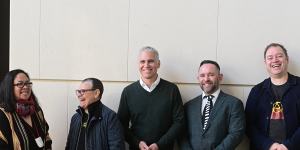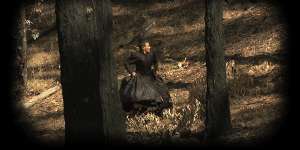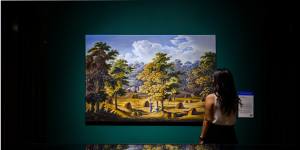The Kamilaroi/Wailwan academic and artist,who uses video,sound and visuals to explore important and often confronting issues,can feel the pull of their kin and their country near Coonabarabran.
“Completing my pHD took me back home to country quite a lot and I realised that I need to spend more time on country,” they say.
“I’m going[back] to maintain my connection to my[artistic] practice,which saves me and makes me understand why I’m here and what my job is to do.”

(left to right) Curator Tina Baum with artists r e a,Christopher Pease,Bruce Johnson McLean,National Gallery Assistant Director,First Nations Engagement and Nathan Pōhio,Senior Curator,Māori Art,Auckland Art Gallery at the opening of Ever Present:First Peoples Art of Australia at Auckland Art Gallery Toi o Tāmaki,2023.Supplied
Country as inspiration
An artist for 32 years,and an academic for 20,r e a says they’re hoping that more time on country will help remedy the exhaustion that comes with years of using art and education as a tool for activism,and inspire new art.
“All aboriginal art is political – whether it’s iconic works on canvas or video works like mine,it’s about our history and the impact of colonisation and how we’re trying to hang onto culture and ceremony and identity through[art] practice,” they say.
“I used to lay on a mattress on summer nights with my grandmother and she talked to us about the stars and let us know that no matter where we are,we will never be disconnected from country if we look at the stars. I want to do a work around that.”

r e a,Gamilaraay/Wailwan/Biripi peoples,PolesApart (video still),2009,National Gallery of Australia,Kamberri/Canberra.Supplied
Art and history enthusiasts will no doubt be curious to see what emerges from r e a’s increased time on country,given their extraordinary knack for using video and colour to explore Aboriginal identity.
r e a’s striking six-minute videoPolesApart is one of over 150 works featured in the National Gallery of Australia Touring Exhibition,Ever Present:First Peoples Art of Australia,currently on display at Auckland Art GalleryToi o Tāmaki in Aotearoa (New Zealand).
A path to healing
The exhibition is the largest major survey of First Nations art to travel outside of Australia,featuring a spread of ceremonial masks and cultural items through to contemporary First Nations art sourced from the National Gallery and the Wesfarmers Collection of Australian Art.
“Art is a visual language for Aboriginal and Torres Strait Islander people[which is used] to highlight confronting issues and highlight cultural stories. It is also a healing mechanism as well,” says Tina Baum,National Gallery’s Curator of Aboriginal and Torres Strait Islander Art.
r e a’s video,shot on land near Daylesford where their grandmother was sent to work as a servant for opera singer Dame Nellie Melba,depicts r e a wearing a Victorian-era maid’s dress dyed black as a symbol of mourning the loss of the First Nations women who died in servant roles and never found a way back to country.
“It was shot on an amazing landscape that had been burnt two years prior and the trees were all black. For me,there was this sense of[the trees as] the elders and their black bodies. There was a sense of renewal and regeneration happening.”
The video ends with r e a being sprayed in red,white and blue,symbolic of the English and American colonisation of the country.
“It’s about,’When will we be truly visible in this landscape where we belong?” they ask.
Educating through art
For Minang/Wardandi/Bibbulmun artist Christopher Pease,from Western Australia,Ever Presentoffers a chance for viewers to learn more about the history of the First Peoples of Australia.
“I hope viewers get a greater understanding of the Indigenous journey and a greater understanding of where Indigenous people may be coming from,” he says.

Christopher Pease,Minang/Wardandi/Bibbulmun peoples,Wrong side of the Hay,2005,installation view,Ever Present:First Peoples Art of Australia,National Gallery,Singapore,2022.Supplied
“The different mediums that are on display have really allowed artists to tell those really important stories – whether they’re cultural or historic – in really innovative ways.”
Pease’s work,Wrong Side of the Hay,was based off a 1798 hand-coloured engraving by artist John Sykes calledDeserted Indian Village. Pease layered a topographical map of the Hay River from the Albany area in Hay Country,as well as reference numbers for some extraordinary artefacts he found in the basement of the West Australian museum.
“The fact[the village was] deserted,is referencing the displacement of the Indigenous people off the land there,” he says.
“After settlement,it was known that if you were on the west side of the Hay[river],you could be shot for trespassing because there were farms in the area.”
Pease is humbled to be featured in the exhibition alongside artists like Albert Namatjira and Emily Kam Kngwarray.
“This show was inspiring because it gives you new ideas and fresh approaches and the fact the quality is so high,it makes you want to lift your game and produce work to a greater level as well,” he says.
“The artists that are around right now are inspirational for emerging artists – it shows your voice can be heard.”
Sharing First Nations art from Australia with Māori viewers offers another level of validation for Indigenous artists.
“Māori artists are really respectful of Indigenous Australian artists,” r e a says.
“To be there and to be honoured by[a culture who view] Indigenous Australians as a highly evolved people,the oldest living race in the world … was another amazing moment of affirmation and a re-affirming for me to go back to practise full-time.”
on display in Aotearoa/New Zealand until 29 October. Ever Present is presented by the National Gallery and Wesfarmers Arts in partnership with Auckland Art Gallery Toi o Tāmaki and supported by the Australian Government.